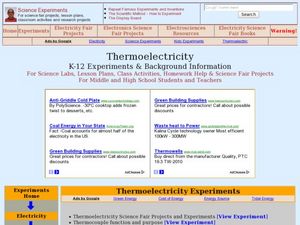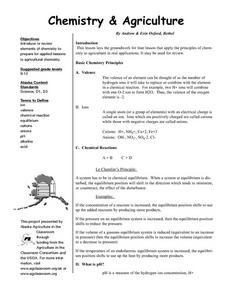Curated OER
The Nature of Salt
High schoolers record information from the periodic table for sodium and chloride. They determine whether salts are molecular or ionic compounds, along with sodium chloride's molecular weight, and relative weights
Space Awareness
Climate Zones
The climate at the equator is hotter than the climate at the poles, but why? The lesson plan goes in depth, explaining how the angles of illumination relate to the heating rate at different latitudes and seasons. Scholars use a strong...
Curated OER
Gases and Plasmas
Students determine what plasma is and why the sun is made up of plasma. They recognize situations where plasmas are found in nature and made by man. They discuss why the sun is a huge ball of plasma and if there are different levels of...
Curated OER
A Home Energy Audit
Learners investigate ways to save energy. In this environmental lesson, students play the role of a building inspector and identify "culprits" that waste energy. Learners use a checklist to identify specific practices that waste energy.
Wild BC
Greenhouse Gas Line-Up
Discuss different sources of energy and how much greenhouse gas each might emit. The six sources are then ranked according to emissions from greatest to least. Finally, the true cumulative emissions are revealed to show the class how...
Curated OER
Wavelengths of Light
Explore physical science by participating in a visual spectrum experiments. Budding scientists identify the colors in the color spectrum and view the colors in class by utilizing cellophane, flash lights, and other arts and crafts...
Curated OER
Circuits
Fifth graders discover the differences between parallel and series circuits. They draw and construct the two types of circuits using wires, bulbs, batteries, sockets, and switches.
Curated OER
Series/Parallel Circuits
Young scholars engage in a lesson that is concerned with the concept of series and parallel circuits. They conduct research using a variety of resources. They have class discussion and the lesson includes information for the teacher to use.
Curated OER
Inventions 1: Edison and the Light Bulb
Students are introduced to the realm and power of inventions, and help them to better recognize their impact on people and society.
Curated OER
Thermoelectricity
High schoolers conduct a series of experiments on thermoelectricity. In this physics lesson, students investigate how thermocouple works. They determine the voltage generated when different conductive materials are held at different...
Curated OER
Luminous Efficacy (Efficiency)
Students examine the basics of luminous efficacy and why it is used. In this light source lesson students test energy efficiency and the luminous efficiency for babies.
Curated OER
Permeability (Magnetism)
High schoolers investigate magnetic permeability and saturation. For this physics lesson, students explain how current carrying wire coils create magnetic forces. They interpret normal magnetization curves.
California Academy of Science
Energy: A Day in My Life
If only we could harness the energy of fifth graders, our energy problems would be over! The class discusses where different forms of energy come from and how we use them. They complete a chart of the activities that they do daily that...
Curated OER
Too Bright at Night?
Students reflect upon the causes and effects of light pollution in the night skies. First, they read articles provided and then do worksheets that are provided. They work in groups to discuss their conclusions.
Curated OER
Basic Chemistry Principles
High schoolers use the basic principles of Chemistry to determine pH levels. Elements of the Periodic Table are also included in this lesson.
Curated OER
Wasting Energy at Home?
Students identify ways that energy is wasted. They develop ideas on how to conserve energy in the home. They also categorize appliances found in the home as heavy, moderate, or light users of energy
Curated OER
Graphing the Facts
Students investigate the correlation between our planet's weather and solar activity. They analyze and discuss data regarding the solar activity cycle, graph annual precipitation and temperature averages over a period of 100 years, and...
Curated OER
Electron Current Flow
Students observe how an electrical current passes through a conductor and the relationship between voltage and resistance. In this investigative lesson students participate in an activity that allows them to see the correlation between...
Curated OER
Eating your Energy's Worth
Students calculate the amount of electrical energy used in a week in food units. They create ways to reduce energy use. Students discuss the different forms and sources of energy. They discuss how people use electrical energy to power...
Curated OER
Alternative Energy
Students identify the five major alternative energy sources. In this physical science instructional activity, students assess the advantages and disadvantages for each type of energy. They complete a concept map using information they...
Curated OER
Teeth and Eating
Students explore animal diets and teeth. In this animal science lesson, students view photos of animals and their teeth. Students identify the type of diet the animal has based on the teeth. Students are introduced to the terms...
Curated OER
Physics Post-Lab
Young scholars explore physics. In this science lesson, students discuss physics in their everyday lives. Young scholars complete a physics worksheet.
Curated OER
The Urban Explosion
Students investigate the uncontrolled development of the world's major cities. They define key vocabulary terms, view and discuss video excerpts, and complete a project that involves drawing a "perfect city," developing a plan to...
Curated OER
Chemistry: Energy Resources and Transfers
Students explore the concepts of energy resources and energy transfers. In this chemistry instructional activity, students examine renewable and non-renewable energy sources as they view classroom demonstrations and discuss the concepts...

























